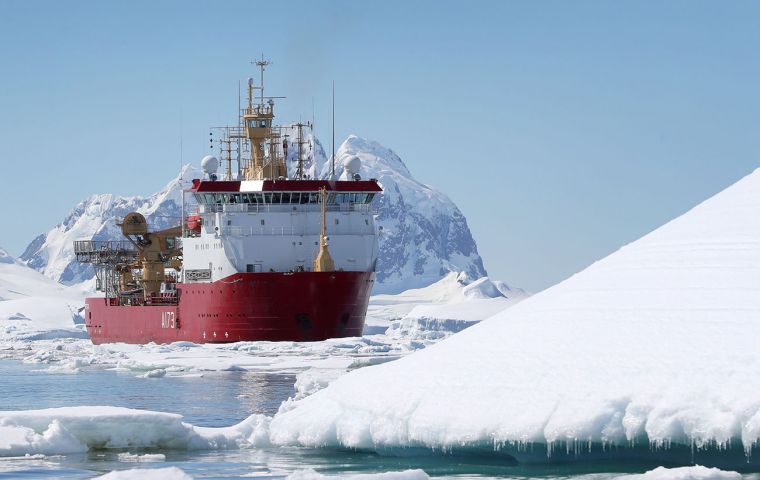MercoPress. South Atlantic News Agency
HMS Protector comes across an iceberg of 11 miles long and five wide
 The Ice patrol was making for the sunken volcano on Deception Island after helping BAS scientists conduct geological work around the South Shetland Islands. (Referencial image)
The Ice patrol was making for the sunken volcano on Deception Island after helping BAS scientists conduct geological work around the South Shetland Islands. (Referencial image) The Royal Navy’s Antarctic patrol ship encountered an iceberg the size of Bristol as she began her final scientific mission of the season. HMS Protector came across the enormous mass of ice and snow – 11 miles long and five wide – as she returned to the frozen continent for the last time this winter – or summer as it is in the Southern Hemisphere.
The Plymouth-based ship is coming to the end of a deployment to update maps and charts of the seas around Antarctica, support scientists in remote research stations on the frozen continent, and help experts study the effects of global warming on one of the world’s largest glaciers.
She was making for the sunken volcano on Deception Island after helping British Antarctic Survey scientists conduct geological work around Cape Melville in the South Shetland Islands – 500 miles from the southern tip of South America, Cape Horn – when she came across the mammoth berg
The large iceberg is so big that it clearly shows up on satellite imagery of the Bransfield Strait, which separates the South Shetland Island chain from the end of the Antarctic Peninsula.
The iceberg is believed to be one given an official designation by scientists – A57A. It broke away from the Filchner-Ronne Ice Shelf in the Weddell Sea – some 1,100 miles from where
Protector encountered it – more than a decade ago. From observations from other Antarctic travelers and explorers, it looks like it is melting at a rate of about nine per cent of its size at present.
“The large iceberg we sailed past was an astonishing 11 miles by five,” said Captain Matt Syrett, Protector’s Commanding Officer. “Along its edge large chunks of ice had calved off, leaving the appearance of a cave system.”
It was clear to Protector’s crew that the huge mass of ice was slowly melting and disintegrating as it was surrounded by growlers – small chunks of ice – and larger ‘bergy bits’.
With a total area of around 55 square miles (142 square kilometers), the berg is larger than Bournemouth and Poole and nearly as big as Bristol.
It’s still dwarfed by ten other icebergs which have broken away from the Antarctica region over the past 30 years; the largest lump which snapped off according to modern records was more than twice the size of Norfolk. It sheered away from the Ross Ice Shelf and took more than five years to melt, break up and finally vanish.




Top Comments
Disclaimer & comment rules-

-

Read all commentsShe was making for the sunken volcano on Deception Island after helping British Antarctic Survey scientists conduct geological work around Cape Melville in the South Shetland Islands – 500 miles from the southern tip of South America, Cape Horn – when she came across the mammoth berg...
Mar 08th, 2019 - 09:51 am 0South Shetland Islands - claimed by Argentina.
British Sub-Antarctica and Antarctic Islands – Argentinian Claims (2 pgs):-
https://www.academia.edu/38179055/British_Sub-Antarctica_and_Antarctic_Islands_Argentinian_Claims
Has somebody iced over Malta?
Mar 09th, 2019 - 12:43 pm 0Commenting for this story is now closed.
If you have a Facebook account, become a fan and comment on our Facebook Page!